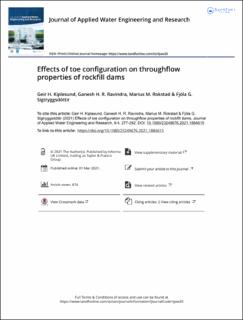| dc.contributor.author | Kiplesund, Geir Helge | |
| dc.contributor.author | Hiriyanna Rao Ravindra, Ganesh | |
| dc.contributor.author | Rokstad, Marius Møller | |
| dc.contributor.author | Sigtryggsdottir, Fjola Gudrun | |
| dc.date.accessioned | 2022-03-02T09:52:07Z | |
| dc.date.available | 2022-03-02T09:52:07Z | |
| dc.date.created | 2021-03-09T11:43:02Z | |
| dc.date.issued | 2021 | |
| dc.identifier.citation | Journal of Applied Water Engineering and Research. 2021, 9 (4), 277-292. | en_US |
| dc.identifier.issn | 2324-9676 | |
| dc.identifier.uri | https://hdl.handle.net/11250/2982366 | |
| dc.description.abstract | Rockfill dams must be equipped with defence mechanisms to counteract the destabilizing effects of throughflow forces under accidental leakage scenarios. A key component of the rockfill dam overtopping system is the rockfill dam toe, constructed in tandem with the downstream rockfill shoulder. Quantitative descriptions of effects of different toe configurations on throughflow hydraulic properties of rockfill dams are currently unavailable in international literature. To address this, experimental investigations were conducted on 1 m high model rockfill dams with disparate toe configurations. Investigation outcomes describe the effects of internal, external and combined toe configurations on pore-pressure distributions within rockfill dam models subjected to throughflow conditions. Research outcomes provide vital information which can facilitate effective decision-making with regards to rockfill dam design. The accumulated data sets could also enable development, calibration and validation of numerical design tools and dam breach models. | en_US |
| dc.language.iso | eng | en_US |
| dc.publisher | Taylor & Francis | en_US |
| dc.rights | Navngivelse 4.0 Internasjonal | * |
| dc.rights.uri | http://creativecommons.org/licenses/by/4.0/deed.no | * |
| dc.title | Effects of toe configuration on throughflow properties of rockfill dams | en_US |
| dc.type | Peer reviewed | en_US |
| dc.type | Journal article | en_US |
| dc.description.version | publishedVersion | en_US |
| dc.source.pagenumber | 277-292 | en_US |
| dc.source.volume | 9 | en_US |
| dc.source.journal | Journal of Applied Water Engineering and Research | en_US |
| dc.source.issue | 4 | en_US |
| dc.identifier.doi | 10.1080/23249676.2021.1884615 | |
| dc.identifier.cristin | 1896607 | |
| dc.relation.project | Norges forskningsråd: 257588 | en_US |
| cristin.ispublished | true | |
| cristin.fulltext | original | |
| cristin.qualitycode | 1 | |

